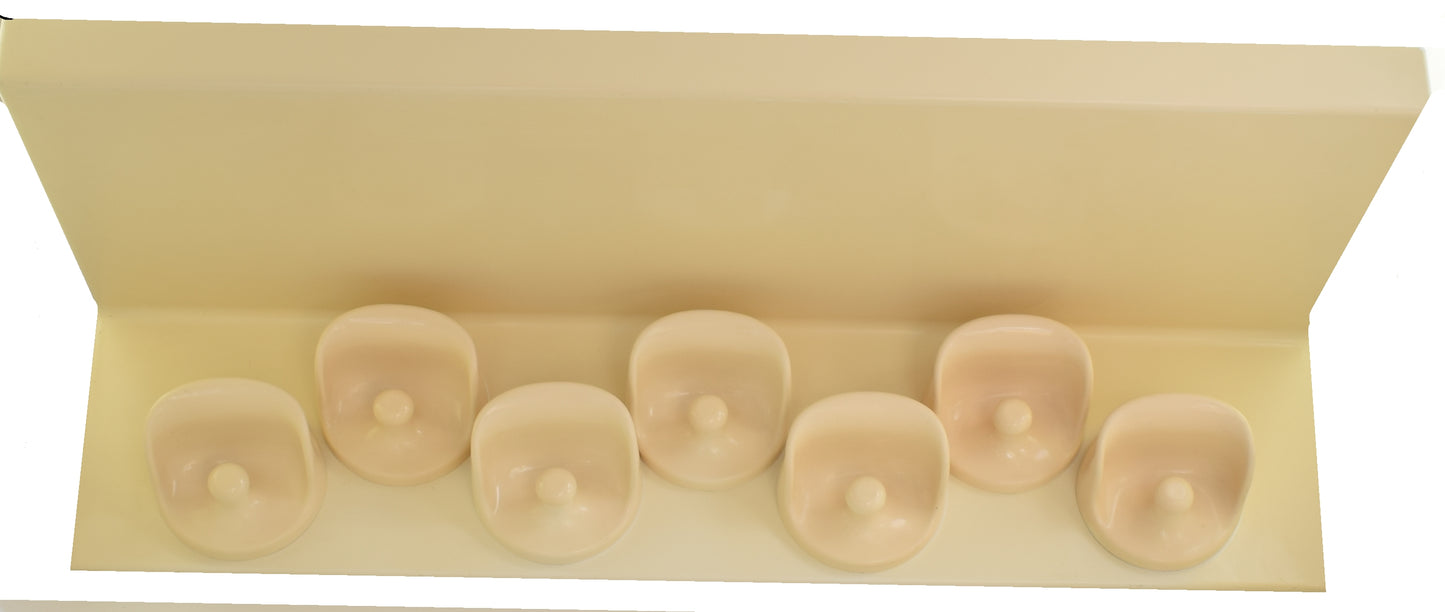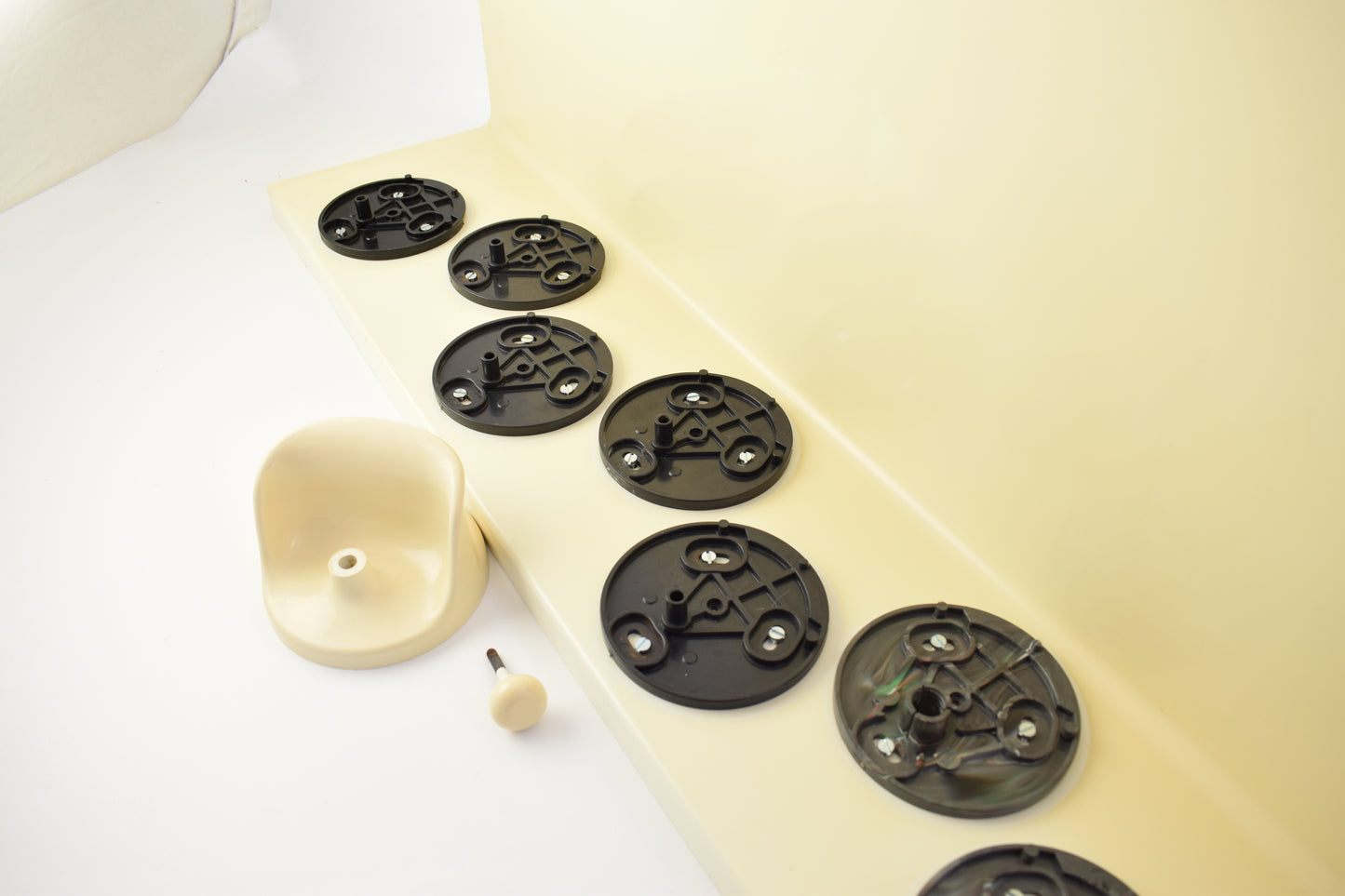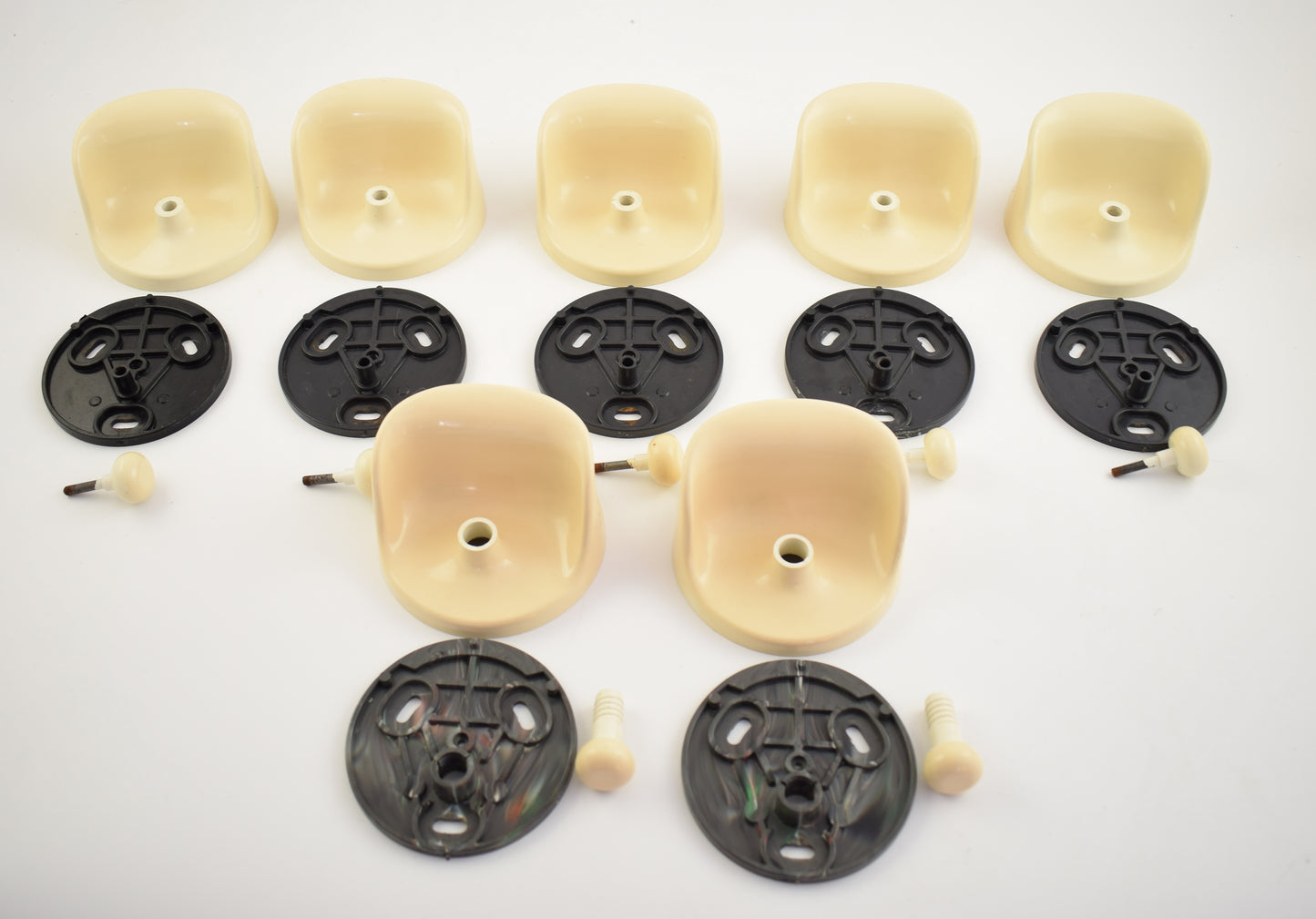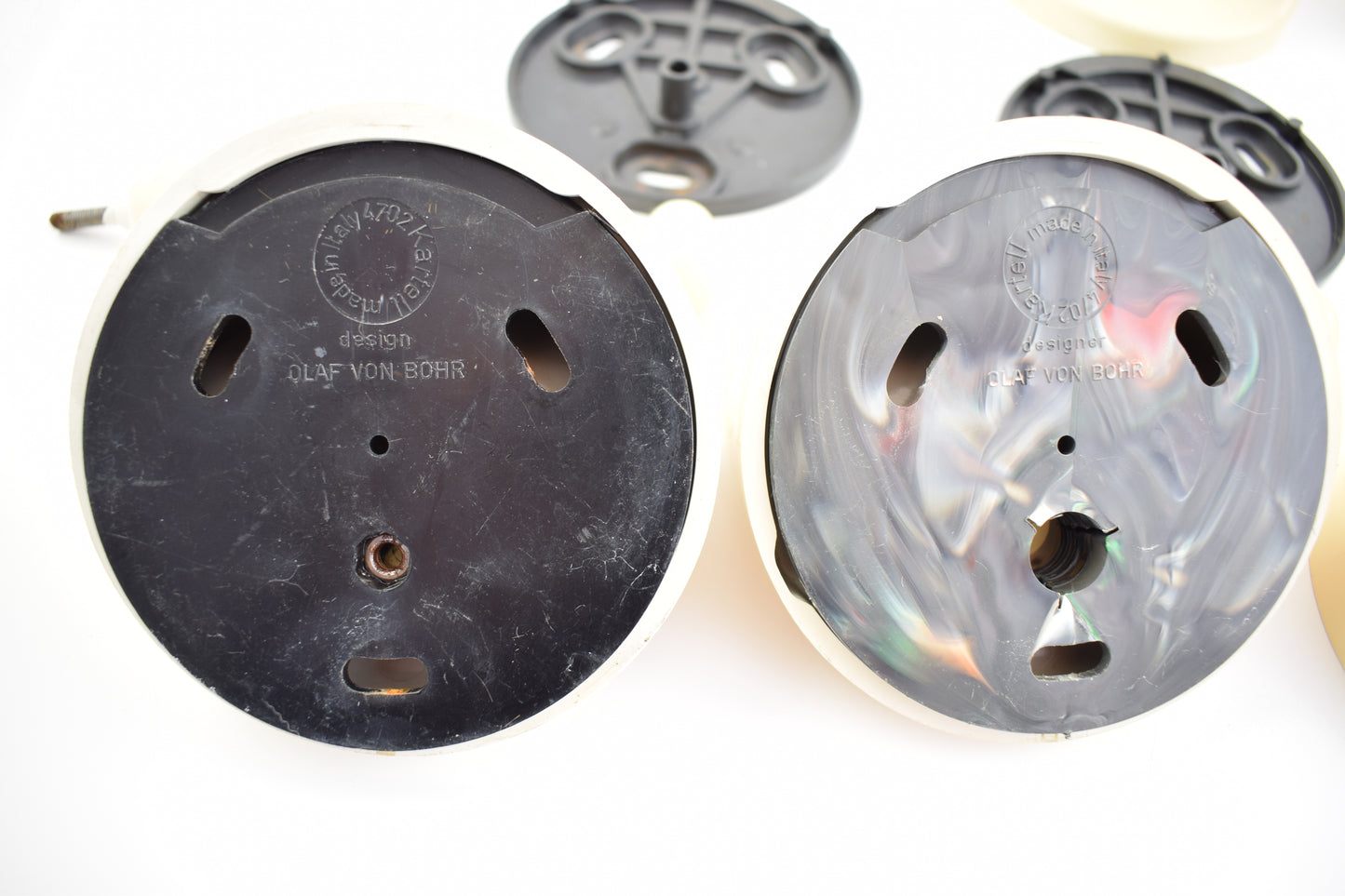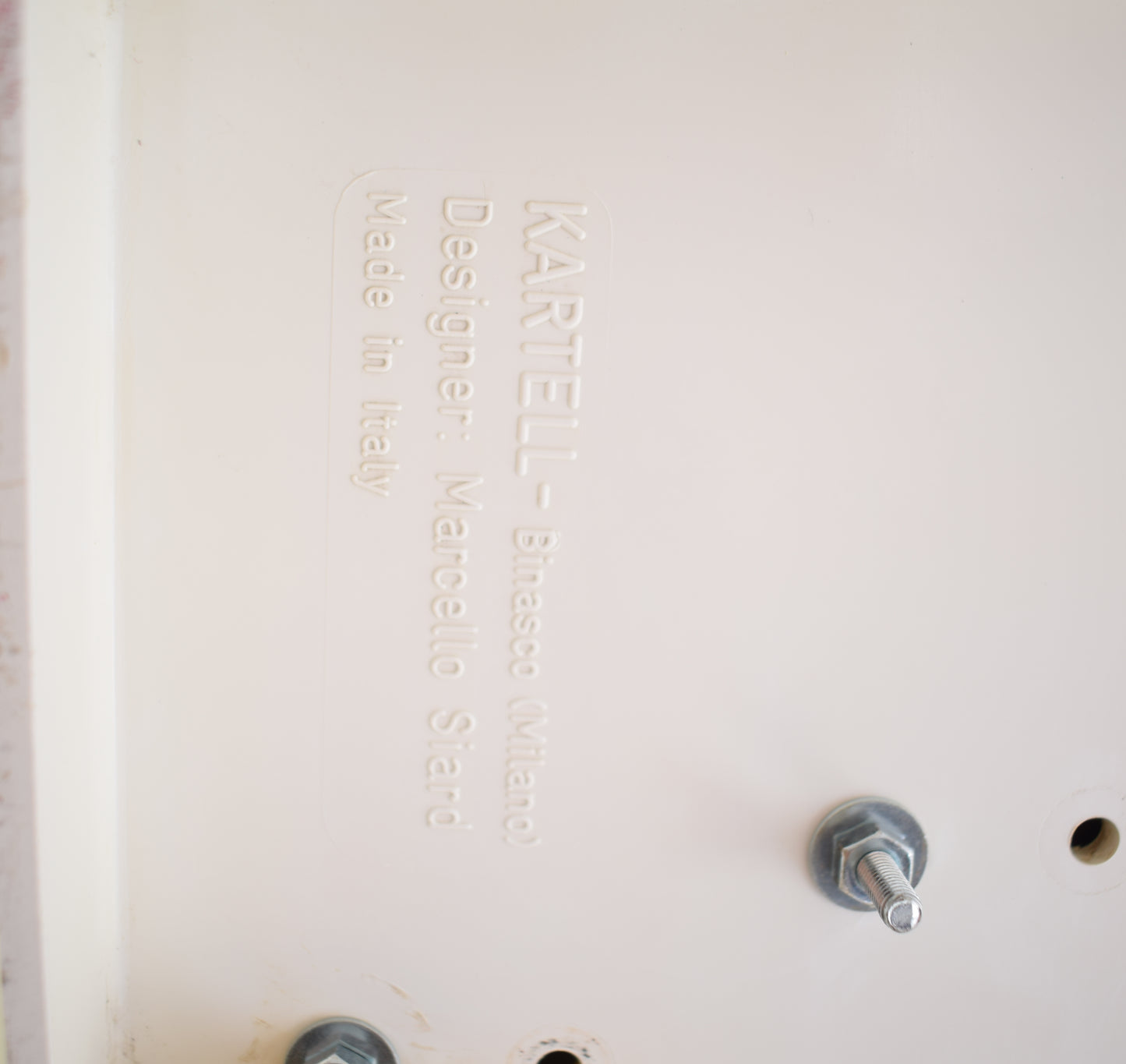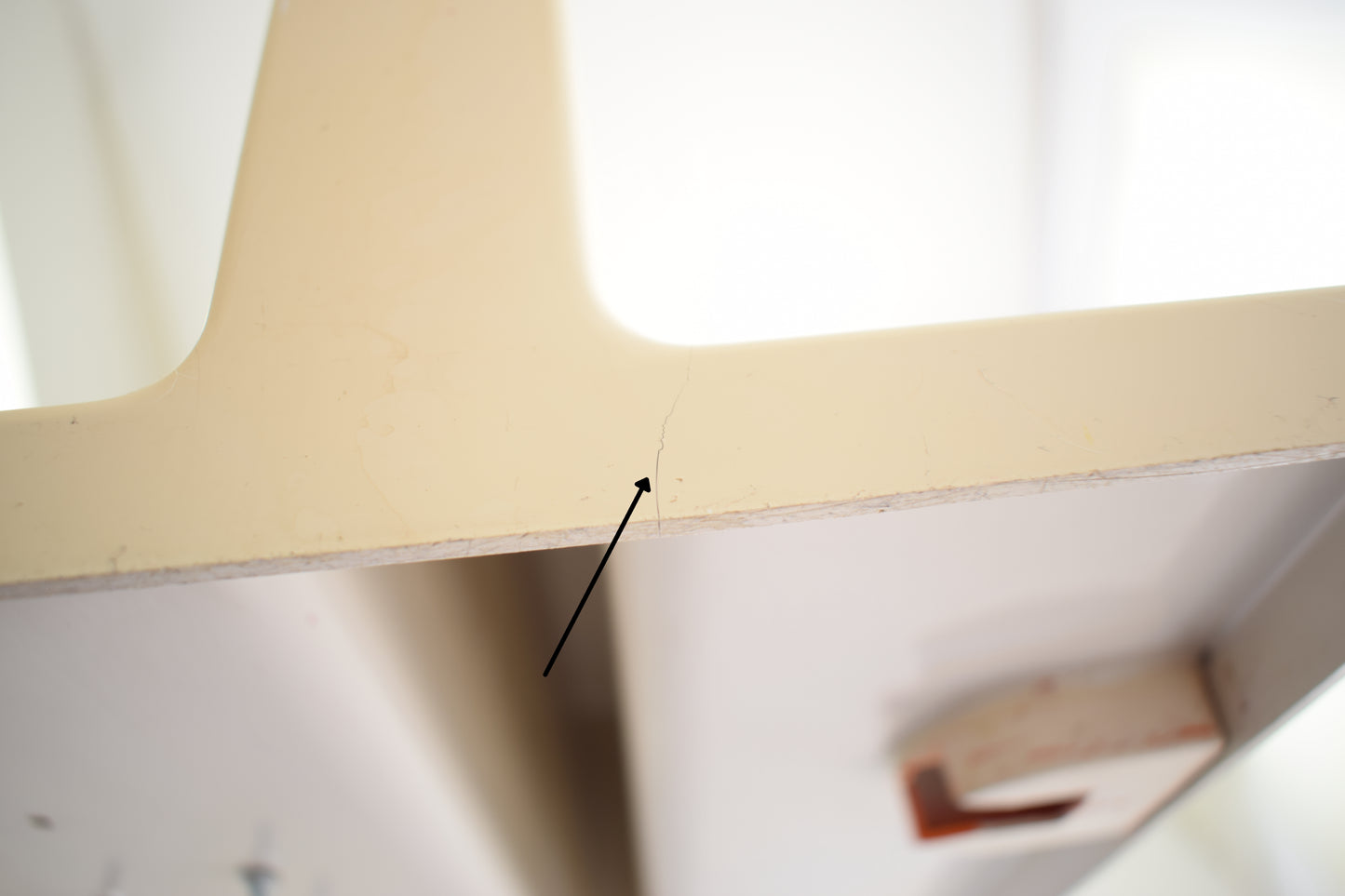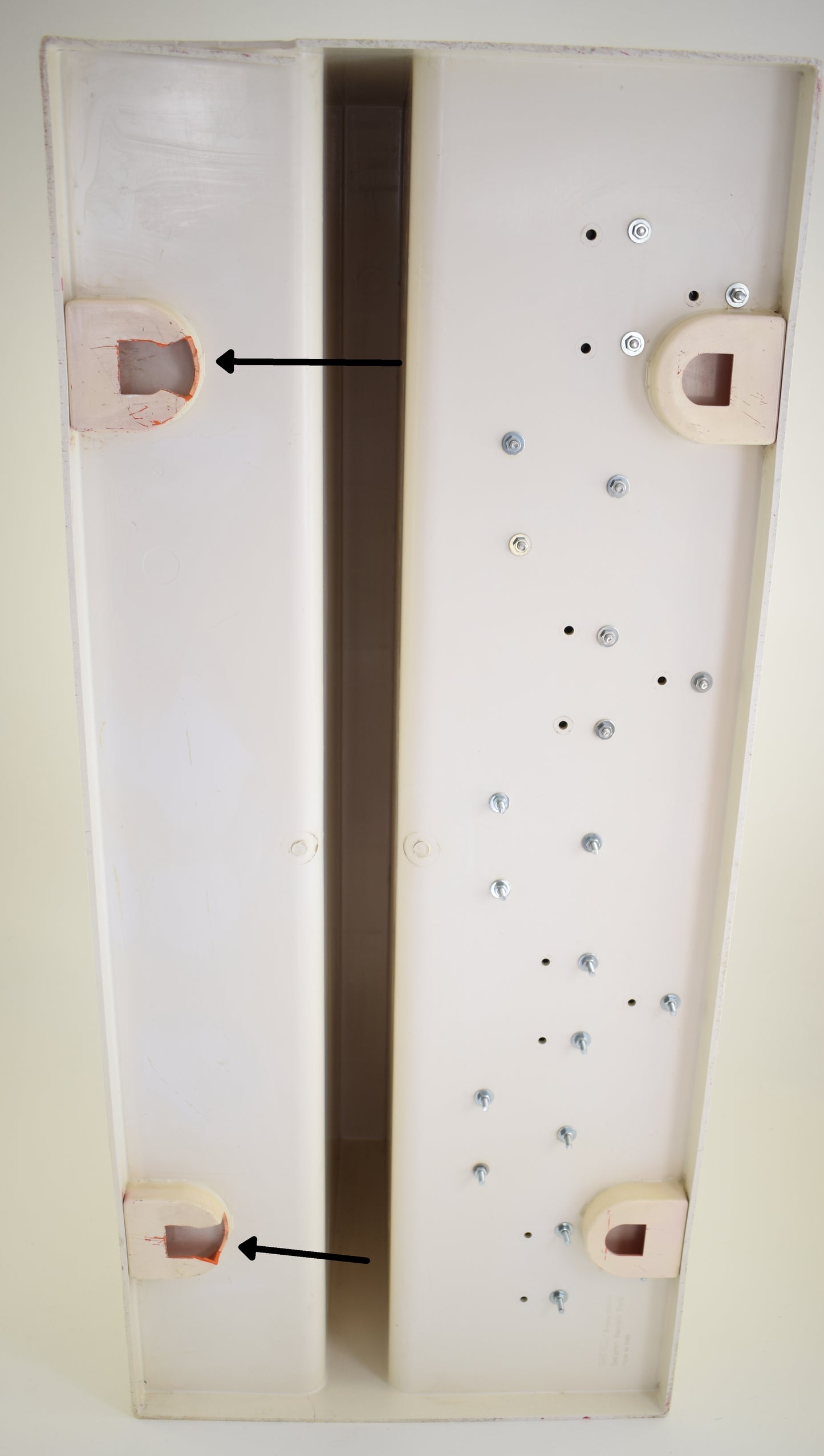Decirculo
Kartell Coat rack with Shelf from Marcello Siard and Olaf Von Bohr , Binasco Milano Italy 1970s
Kartell Coat rack with Shelf from Marcello Siard and Olaf Von Bohr , Binasco Milano Italy 1970s
Precio habitual
€249,00 EUR
Precio habitual
Precio de oferta
€249,00 EUR
Precio unitario
/
por
Los gastos de envío se calculan en la pantalla de pago.
No se pudo cargar la disponibilidad de retiro
White crème Kartell Coat rack with Shelf from Marcello Siard and Olaf Von Bohr , Binasco Milano Italy 1970s
ABS plastic coatrack with 7 hooks and hat shelf designed by Marcello Siard (coat rack) and hooks from Olav von Bohr for Kartell in 1972. BOTH Rack (Siard) and Hangers (Bohr) are signed (see pictures) It has some discoloration like most white plastics from the 1970s.
Two of the hangers are a bit newer then other 5 but still made in the 1970s. The rack is some damaged at one side but if your handy you should be able to glue it, other side shows also a very very tiny crack and some little plastic removed on the back from the coat shelf hanger although that's not visible from outside and the shelf can still hang on it. Price reduced for the damage on the shelf, please take a good look at the pictures.
The rack itself has the Marcello Siard label which is already rare and highly sought but the signed Bohr hangers can be removed and hanged separately without the shelf.
Width 79 cm (31.5 inch)
Depth 31 cm (12.2 inch)
Height 35 cm (13.78 inch)
Kartell
Specialized in luxury plastic furniture and decorative objects, Italian design brand Kartell was founded by Giulio Castelli (1920-2006) and his wife Anna Ferrieri (1918-2006) in Milan in 1949. The son of a plastics researcher, Castelli was attracted to experimental, new materials from an early age and went on to study chemical engineering under Nobel Prize winning chemist Giulio Natta. Ferrieri, meanwhile, studied architecture at the Politecnico di Milano under influential, neo-rationalist architect-designer Franco Albini.
In the early years of the postwar era, Castelli and Ferrieri were eager to contribute to their country’s reconstruction through high quality and innovative industrial design. At first the company concentrated on automotive accessories, like the K101 Ski Rack (1950). In 1953, however, Kartell launched its Housewares Division and began to produce the eye-catching, molded plastic interiors objects for which the company is internationally known today.
In the 1950s, polypropylene plastic was still widely thought to be an unusual material for domestic settings. Kartell’s earliest designs tended to be small tools for the kitchen. Highlights from this phase of Kartell’s history include the KS 1146 Bucket (1955), KS 1475 Carpet Beater (1957), KS 1068 Standing Dustpan (1958), KS 1481 Lemon Squeezer (1959), and Model KS 1171/2 Dish Drainer (1960), all by designer Gino Colombini and all in the permanent collection of New York’s Museum of Modern Art. Colombini’s bucket was awarded a Compasso d’Oro prize in 1955.
In the 1960s, Castelli and Ferrieri became determined to change perceptions of plastic by using it in the creation of stylish yet functional furniture and interior décor. The Habitat Division of Kartell launched in 1963 and led to the K 4999/K 1340 Children’s Chair, designed by Marco Zanuso and Richard Sapper in 1964—the world’s first plastic chair and a Compasso d’Oro winner in ’64. The following year, Joe Colombo worked with Kartell to produce the bent plywood 4801 Chair (1965), Kartell’s only wholly wood product.
In 1967, Kartell inaugurated its new headquarters in Noviglio, designed by Ferrieri and, since 1999, home to the Museo Kartell. That same year, Colombo created Kartell’s 4867 Universal Chair (1967), the first chair made in a single piece using injection-molded plastic. Now considered a landmark of design history, the Universal Chair is found in museum collections the world over. Other iconic Kartell designs from the 1960s include Colombo’s KD27 Table Lamp (1967), Gae Aulenti’s Re Sole Lamp (1967), and Ferrieri’s 4966 Componibili Storage Module (1969).
Kartell’s place in design history hit a new level when the company’s designs were included in the legendary Italy: The New Domestic Landscape exhibition at MoMA New York in 1972. Kartell’s molded plastic pieces fit perfectly alongside the space-age aesthetics of designers and studios like Archizoom, the Castiglioni brothers, Vico Magistretti, Gaetano Pesce, Ettore Sottsass, and Superstudio, who were all also exhibited in this vanguard show.
In 1988, the Castelli couple decided to sell their company to their son-in-law, former managing director of Versace, Claudio Luti. After ten years in the fashion industry, the Italian entrepreneur took over Kartell and expanded the roster of contributing designers to include the likes of Ron Arad, Antonio Citterio, Vico Magistretti, Philippe Starck, and Marteen van Severen. As a result, the 1990s and early 2000s proved highly successful for Kartell. Standouts from this turn-of-the-millennium era include Arad’s Bookworm Wall Shelf (1994), Citterio’s Mobil Drawers System (1994), Magistretti’s Maui Chair (1996), Starck’s La Marie Chair (1998), van Severen’s LCP Chair (1999), Starck’s Bubble Club Sofa (2000), and Starck’s Louis Ghost Chair (2002).
Today, Kartell continues to serve as a benchmark in contemporary design culture. In recent years, Kartell has produced the designs of Front, Nendo, Patricia Urquiola, and Tokujin Yoshioka, to name a few. The company’s designs can be found in public and private museums around the world.
For more information, see Kartell: The Culture of Plastics, published by Taschen in 2013.
ABS plastic coatrack with 7 hooks and hat shelf designed by Marcello Siard (coat rack) and hooks from Olav von Bohr for Kartell in 1972. BOTH Rack (Siard) and Hangers (Bohr) are signed (see pictures) It has some discoloration like most white plastics from the 1970s.
Two of the hangers are a bit newer then other 5 but still made in the 1970s. The rack is some damaged at one side but if your handy you should be able to glue it, other side shows also a very very tiny crack and some little plastic removed on the back from the coat shelf hanger although that's not visible from outside and the shelf can still hang on it. Price reduced for the damage on the shelf, please take a good look at the pictures.
The rack itself has the Marcello Siard label which is already rare and highly sought but the signed Bohr hangers can be removed and hanged separately without the shelf.
Width 79 cm (31.5 inch)
Depth 31 cm (12.2 inch)
Height 35 cm (13.78 inch)
Kartell
Specialized in luxury plastic furniture and decorative objects, Italian design brand Kartell was founded by Giulio Castelli (1920-2006) and his wife Anna Ferrieri (1918-2006) in Milan in 1949. The son of a plastics researcher, Castelli was attracted to experimental, new materials from an early age and went on to study chemical engineering under Nobel Prize winning chemist Giulio Natta. Ferrieri, meanwhile, studied architecture at the Politecnico di Milano under influential, neo-rationalist architect-designer Franco Albini.
In the early years of the postwar era, Castelli and Ferrieri were eager to contribute to their country’s reconstruction through high quality and innovative industrial design. At first the company concentrated on automotive accessories, like the K101 Ski Rack (1950). In 1953, however, Kartell launched its Housewares Division and began to produce the eye-catching, molded plastic interiors objects for which the company is internationally known today.
In the 1950s, polypropylene plastic was still widely thought to be an unusual material for domestic settings. Kartell’s earliest designs tended to be small tools for the kitchen. Highlights from this phase of Kartell’s history include the KS 1146 Bucket (1955), KS 1475 Carpet Beater (1957), KS 1068 Standing Dustpan (1958), KS 1481 Lemon Squeezer (1959), and Model KS 1171/2 Dish Drainer (1960), all by designer Gino Colombini and all in the permanent collection of New York’s Museum of Modern Art. Colombini’s bucket was awarded a Compasso d’Oro prize in 1955.
In the 1960s, Castelli and Ferrieri became determined to change perceptions of plastic by using it in the creation of stylish yet functional furniture and interior décor. The Habitat Division of Kartell launched in 1963 and led to the K 4999/K 1340 Children’s Chair, designed by Marco Zanuso and Richard Sapper in 1964—the world’s first plastic chair and a Compasso d’Oro winner in ’64. The following year, Joe Colombo worked with Kartell to produce the bent plywood 4801 Chair (1965), Kartell’s only wholly wood product.
In 1967, Kartell inaugurated its new headquarters in Noviglio, designed by Ferrieri and, since 1999, home to the Museo Kartell. That same year, Colombo created Kartell’s 4867 Universal Chair (1967), the first chair made in a single piece using injection-molded plastic. Now considered a landmark of design history, the Universal Chair is found in museum collections the world over. Other iconic Kartell designs from the 1960s include Colombo’s KD27 Table Lamp (1967), Gae Aulenti’s Re Sole Lamp (1967), and Ferrieri’s 4966 Componibili Storage Module (1969).
Kartell’s place in design history hit a new level when the company’s designs were included in the legendary Italy: The New Domestic Landscape exhibition at MoMA New York in 1972. Kartell’s molded plastic pieces fit perfectly alongside the space-age aesthetics of designers and studios like Archizoom, the Castiglioni brothers, Vico Magistretti, Gaetano Pesce, Ettore Sottsass, and Superstudio, who were all also exhibited in this vanguard show.
In 1988, the Castelli couple decided to sell their company to their son-in-law, former managing director of Versace, Claudio Luti. After ten years in the fashion industry, the Italian entrepreneur took over Kartell and expanded the roster of contributing designers to include the likes of Ron Arad, Antonio Citterio, Vico Magistretti, Philippe Starck, and Marteen van Severen. As a result, the 1990s and early 2000s proved highly successful for Kartell. Standouts from this turn-of-the-millennium era include Arad’s Bookworm Wall Shelf (1994), Citterio’s Mobil Drawers System (1994), Magistretti’s Maui Chair (1996), Starck’s La Marie Chair (1998), van Severen’s LCP Chair (1999), Starck’s Bubble Club Sofa (2000), and Starck’s Louis Ghost Chair (2002).
Today, Kartell continues to serve as a benchmark in contemporary design culture. In recent years, Kartell has produced the designs of Front, Nendo, Patricia Urquiola, and Tokujin Yoshioka, to name a few. The company’s designs can be found in public and private museums around the world.
For more information, see Kartell: The Culture of Plastics, published by Taschen in 2013.
Compartir
